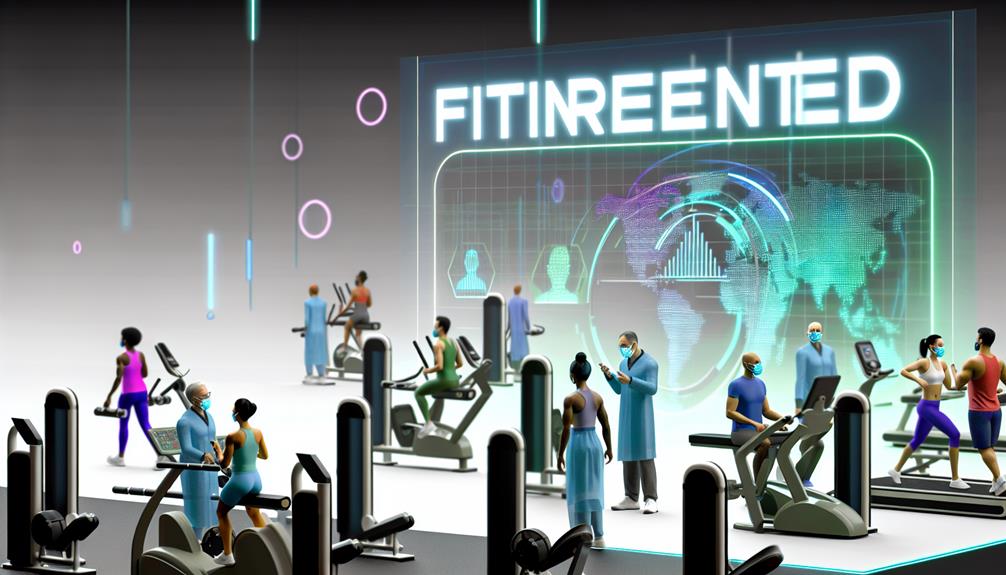You may be inclined to think that the fitness industry has taken a major hit due to the COVID-19 pandemic, but the truth is that it has actually been undergoing a significant transformation. The closure of gyms and fitness centers has forced people to find alternative ways to stay active, resulting in a surge in virtual fitness options. However, this is just the tip of the iceberg. There are several other ways in which the pandemic has shaped the fitness industry, and in this discussion, we will explore these changes and their impact on the future. So, grab your water bottle and get ready to discover how COVID-19 is shaping the fitness industry in ways you never imagined.
Key Takeaways
- Rise of virtual fitness: The pandemic has led to gym closures and a surge in popularity of virtual fitness platforms, offering a wide range of exercise classes and workouts online. The convenience and flexibility of virtual fitness options and the availability of online fitness communities have contributed to this trend.
- Increase in at-home workout equipment sales: With the importance of maintaining physical health during challenging times, there has been an increased demand for at-home workout equipment. The global fitness equipment market is projected to reach $15.2 billion by 2027. The convenience and flexibility of working out at home and the introduction of innovative products by fitness equipment manufacturers have fueled this growth.
- Embracing technology for personalized virtual training: Wearable technology is being used to track activity levels and health metrics, while online fitness platforms provide access to a wide range of workout programs and classes. Real-time feedback and guidance during virtual workouts, along with the flexibility to choose from various instructors and workout styles, are revolutionizing workouts through the power of technology.
- Impact of social distancing on group fitness classes: Social distancing measures have led to changes in group fitness classes, with a transition to online fitness classes and virtual workouts. Despite the physical distance, virtual classes offer a sense of community and structured workout routines. Engaging in collective exercise sessions virtually also provides mental health benefits and the opportunity to connect with others and find support in a virtual community.
- Future of the fitness industry post-pandemic: The fitness industry is expected to undergo transformation post-pandemic, with changing consumer behavior towards home workouts and digital fitness platforms. Fitness businesses will need to invest in technology and online platforms, while also emphasizing cleanliness and hygiene in fitness facilities. As restrictions ease, the industry is expected to experience a strong recovery.
Gym Closures and the Rise of Virtual Fitness
With gym closures becoming increasingly common during the COVID-19 pandemic, virtual fitness has emerged as a popular and accessible alternative for individuals seeking to maintain their physical well-being. Virtual fitness platforms and online fitness communities have experienced a significant surge in popularity as people look for ways to stay active and fit from the comfort and safety of their own homes.
Virtual fitness platforms offer a wide range of exercise classes and workouts that can be accessed from anywhere with an internet connection. Whether it's yoga, HIIT, or dance, these platforms provide a variety of options to cater to different fitness levels and interests. They often include live classes as well as pre-recorded sessions, allowing users to choose what works best for their schedule.
In addition to the convenience and flexibility of virtual fitness platforms, online fitness communities have also played a crucial role in keeping individuals motivated and engaged. These communities provide a sense of connection and support, allowing users to interact with like-minded individuals, share their progress, and receive encouragement and advice.
The rise of virtual fitness during the pandemic has highlighted the power of technology in bridging the gap between individuals and fitness professionals. It has demonstrated that staying active and fit is possible even in challenging times. So, whether you're a beginner or a seasoned fitness enthusiast, virtual fitness platforms and online fitness communities offer a convenient and effective way to prioritize your physical well-being from the comfort of your own home.
The Surge in At-Home Workout Equipment Sales
The demand for at-home workout equipment has skyrocketed as individuals seek to create their own fitness spaces and maintain their exercise routines during the COVID-19 pandemic. With gyms closed and social distancing measures in place, people are turning to at-home fitness trends and investing in fitness equipment to stay active and healthy.
The surge in at-home workout equipment sales is evident in the market. According to a recent report by Research and Markets, the global fitness equipment market is projected to reach $15.2 billion by 2027, growing at a CAGR of 3.6% from 2020 to 2027. This increase in demand can be attributed to several factors.
Firstly, people are realizing the importance of maintaining their physical health during these challenging times. Regular exercise not only helps strengthen the immune system but also reduces stress and improves mental well-being. Secondly, the convenience of working out at home is appealing to many. With busy schedules and limited time, having a fitness space within the comfort of your own home allows for flexibility and consistency in workouts.
In response to the surge in demand, fitness equipment manufacturers have been quick to adapt. Many have introduced innovative products that cater to different fitness levels and preferences. From high-tech treadmills and stationary bikes to compact dumbbells and resistance bands, there is a wide range of options available to suit individual needs.
Embracing Technology for Personalized Virtual Training
To enhance your fitness journey, embrace the power of technology for personalized virtual training that caters to your unique needs and goals. With the rise of wearable technology and online fitness platforms, you now have access to a wide range of tools and resources that can revolutionize your workouts.
Wearable technology, such as fitness trackers and smartwatches, can provide valuable insights into your daily activity levels, heart rate, sleep patterns, and even stress levels. By monitoring these metrics, you can gain a better understanding of your overall health and make informed decisions about your training and recovery.
Online fitness platforms offer a vast array of workout programs and classes that can be tailored to your specific goals and preferences. These platforms often provide real-time feedback and guidance, ensuring that you maintain proper form and technique during your workouts. Additionally, many platforms offer the flexibility to choose from a variety of instructors and workout styles, allowing you to find the perfect fit for your needs.
The Impact of Social Distancing on Group Fitness Classes
As social distancing measures persist, the landscape of group fitness classes has undergone significant changes, greatly impacting how individuals engage in collective exercise sessions. With the need to maintain physical distance from others, traditional in-person group fitness classes have been put on hold. However, fitness enthusiasts have quickly adapted to this new reality by turning to online alternatives.
Online fitness classes have become increasingly popular during these times. Through video platforms and fitness apps, individuals can now participate in group workouts from the comfort of their own homes. These virtual classes not only provide a sense of community but also offer the opportunity to follow structured workout routines led by professional instructors. Moreover, online alternatives often offer a wide variety of classes, catering to different fitness levels and preferences.
The impact of social distancing on group fitness classes goes beyond physical exercise. Engaging in collective exercise sessions has been shown to have significant mental health benefits. It boosts mood, reduces stress, and promotes social interaction, all of which are crucial during these challenging times. While online alternatives may not fully replicate the experience of an in-person class, they still provide an avenue for individuals to connect with others, share their fitness journey, and find support in a virtual community.
The Future of the Fitness Industry Post-Pandemic

The fitness industry is poised for transformation in the wake of the COVID-19 pandemic. As the world begins to recover, the fitness industry is facing a new reality and must adapt to changing consumer behavior. The pandemic has forced many fitness businesses to close their doors temporarily, leading to significant financial losses. However, as restrictions ease and people start to prioritize their health and well-being again, the industry is expected to make a strong recovery.
One of the key factors shaping the future of the fitness industry is changing consumer behavior. The pandemic has caused a shift in how people approach fitness, with many turning to home workouts and digital fitness platforms. This trend is likely to continue even after the pandemic is over, as people have become accustomed to the convenience and flexibility of exercising at home.
To meet the evolving needs of consumers, fitness businesses will need to invest in technology and online platforms. Virtual fitness classes, personalized workout apps, and interactive fitness equipment are just some of the ways that the industry is adapting to the new normal. Additionally, there will likely be an increased emphasis on cleanliness and hygiene in fitness facilities, with more stringent sanitization measures in place to ensure the safety of members.
Frequently Asked Questions
How Long Do Gym Closures Due to COVID-19 Typically Last?
Gym closures due to COVID-19 can last anywhere from a few weeks to several months, depending on the severity of the pandemic. The impact on the fitness industry is significant, forcing businesses to adapt with virtual classes and strict reopening strategies.
What Are Some Popular At-Home Workout Equipment Options That Have Seen Increased Sales During the Pandemic?
Looking to stay fit at home? Popular workout equipment options like dumbbells, resistance bands, and yoga mats have seen increased sales during the pandemic. Stay active and motivated with these essentials!
How Do Virtual Training Programs Personalize Workouts for Individuals?
Looking for a personalized fitness plan? Virtual training programs have got you covered. They use innovative technology to assess your goals, fitness level, and preferences, tailoring workouts specifically to you. Join virtual fitness communities and reach your fitness goals from the comfort of home.
What Safety Measures Are Being Implemented in Group Fitness Classes During Social Distancing?
To ensure safety during group fitness classes while practicing social distancing, fitness centers have implemented various measures. These include reduced class sizes, mandatory mask-wearing, frequent sanitization, and the option of virtual workouts through online platforms.
What Are Some Predicted Long-Term Changes for the Fitness Industry After the Pandemic?
Are you wondering about the future of the fitness industry after the pandemic? Well, get ready for some exciting changes! Workout trends will soar and the industry will experience massive growth. It's like a phoenix rising from the ashes!
Conclusion
In conclusion, the COVID-19 pandemic has significantly transformed the fitness industry. Gym closures have led to a surge in virtual fitness options, with at-home workout equipment sales skyrocketing. Technology has played a crucial role in providing personalized virtual training to individuals. However, the impact of social distancing on group fitness classes cannot be ignored. As we look towards the future, one question lingers: Will the fitness industry fully adapt to these changes and create a new era of innovative and inclusive fitness experiences?













